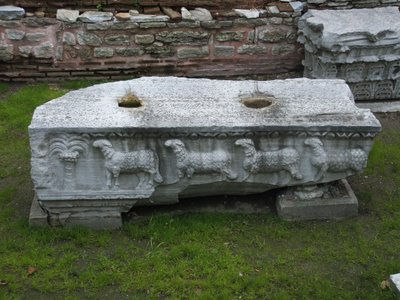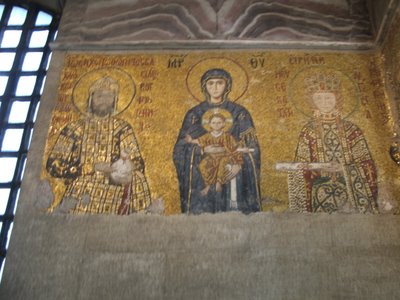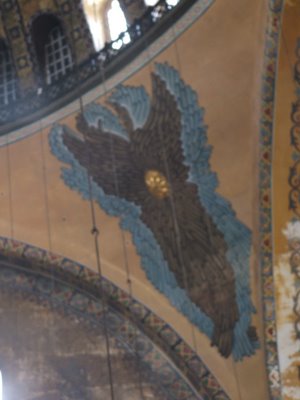Holy Wisdom
After Constantine declared Christianity to be the official religion of his empire, he built a basilica, which proceeded to burn down. These pieces of stone are all that remain of the original-- whatever is still there is underneath the present building, and will stay that way.

In its place, his son Constantine II had the present Hagia Sophia built in a matter of just under six years, which is Really, Really Impressive. It's the classic of Byzantine architecture to boot, and those architects really knew what they were doing: It has stood firm for the past 1500+ years in a land strewn with earthquake induced rubble-- and Turkey gets some bad ones. On top of that (not to cause a pun) the dome is still a feat of engineering, as its weight has been unsupported by any free-standing pillars, only by the walls of the place. Once upon a time there was an opening at the top of the dome to let in sunlight, but that has been altered.

The inside of the place is a riot of gorgeous mosaics and decorative frescoes, always and continuously being maintained. When the Muslims re-took Istanbul and made the basilica into a mosque in the 1500's, they covered many of these over with plaster. In the 1930's the place was declared a museum, and restoration has been taking place.
If you are of English or French descent, be embarrassed. The culture from which you sprang deemed this place worthy only to be used as a stable in the first world war.

If you are of Scandinavian descent, be embarrassed.

My ancestors were thugs, too.
If you are of Middle Eastern descent, be embarrassed. It was a better-looking building before your ancestors got to it.

One last picture which I love: a fresco of the classic angel of Ezekiel:

There used to be a face where the gold shield is now. I can't decide whether that is good or bad. In any case, I find it ironic that humanity could erect such a place, name it for Holy Wisdom, and then proceed to trash it in various ways. I guess that's an apt summary of humanity, so perhaps the testimony of the museum is its own lesson to us.

In its place, his son Constantine II had the present Hagia Sophia built in a matter of just under six years, which is Really, Really Impressive. It's the classic of Byzantine architecture to boot, and those architects really knew what they were doing: It has stood firm for the past 1500+ years in a land strewn with earthquake induced rubble-- and Turkey gets some bad ones. On top of that (not to cause a pun) the dome is still a feat of engineering, as its weight has been unsupported by any free-standing pillars, only by the walls of the place. Once upon a time there was an opening at the top of the dome to let in sunlight, but that has been altered.

The inside of the place is a riot of gorgeous mosaics and decorative frescoes, always and continuously being maintained. When the Muslims re-took Istanbul and made the basilica into a mosque in the 1500's, they covered many of these over with plaster. In the 1930's the place was declared a museum, and restoration has been taking place.
If you are of English or French descent, be embarrassed. The culture from which you sprang deemed this place worthy only to be used as a stable in the first world war.

If you are of Scandinavian descent, be embarrassed.

My ancestors were thugs, too.
If you are of Middle Eastern descent, be embarrassed. It was a better-looking building before your ancestors got to it.

One last picture which I love: a fresco of the classic angel of Ezekiel:

There used to be a face where the gold shield is now. I can't decide whether that is good or bad. In any case, I find it ironic that humanity could erect such a place, name it for Holy Wisdom, and then proceed to trash it in various ways. I guess that's an apt summary of humanity, so perhaps the testimony of the museum is its own lesson to us.

0 Comments:
Post a Comment
<< Home